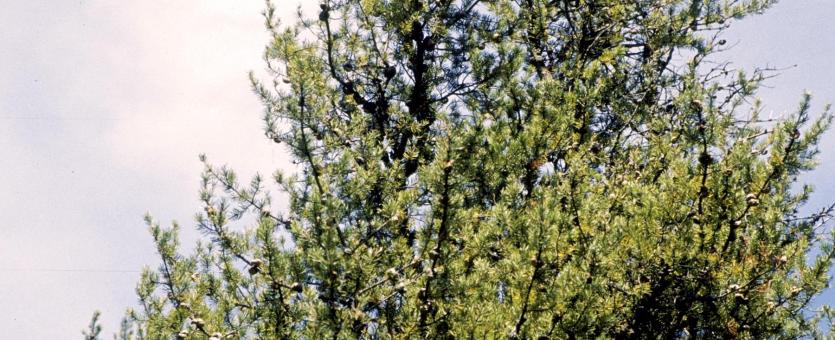
Native to the northeastern United States and Canada, jack pine has been introduced in many other places, including Missouri. This scrubby tree is planted as an ornamental, for windbreaks, or for erosion control. It reproduces locally in and around places where it has been planted.
Jack pine is a small- to medium-sized pine tree with a scrubby, irregular growth habit.
Leaves are needles, ¾–1½ inches long, in bundles of two; stiff, twisted and dull dark green.
Bark is thin, reddish-brown to dark gray, breaking into scaly plates.
Twigs are orangish brown to reddish brown, often with a white waxy coating; turning gray to reddish brown with age.
Conifers do not technically flower. Jack pines shed pollen March–May.
Fruits are cones, 1¼–2 inches long; tan, light brown or yellow-brown; narrowly ovoid; curved or arched; scales not shiny, mostly without spines but sometimes with a small, curved spine near the tip. Cones usually remain closed on the tree for many years.
Similar species:
- Missouri has only one native pine species, the shortleaf pine (Pinus echinata).
- The other five pine species included in our flora are nonnatives (including jack pine) that are commonly planted in timber plantations, for wildlife habitat, for erosion control, or as ornamentals: Austrian pine (P. nigra), eastern white pine (P. strobus), loblolly pine (P. taeda), and scrub pine (P. virginiana). These species frequently produce cones and reproduce themselves within their populations, thus they can become naturalized locally and are counted as part of our state's flora.
- Other pines are grown only as ornamentals or on Christmas tree farms and do not reproduce on their own, so they are not considered part of our flora; these include ponderosa pine (P. ponderosa), red pine (P. resinosa), and Scotch pine (P. sylvestris).
The bottom line is, unless you are at an old home site or at a place where the nonnative pines have been cultivated and might persist on a local scale, the only type of pine you will encounter in the wild in Missouri is almost always the shortleaf pine.
Height: to about 60 feet; spread: 30 feet.

Statewide. It is most likely to thrive north of Missouri River, although it can reproduce statewide.
Habitat and Conservation
In Missouri, jack pine is most commonly seen in landscape plantings as an ornamental or planted as a windbreak. It is native to forests of the northeastern United States and Canada, where it is an important source of pulpwood and lumber. It grows farther north than any other American pine and survives in surprisingly bleak environments. It is useful for wildlife habitat and windbreak plantings. The tree often develops a ragged appearance.
Status
Nonnative. Native to the northeastern United States and Canada. Considered part of Missouri's flora because sometimes it reproduces on its own in our state.
Human Connections
Many thoughtful people contend that humans need to have trees around them, to be healthy and happy. Jack pine, with its scrubby growth form, evokes more of "wildness" than other, more symmetrical pines. Jack pine is also planted to create windbreaks and to prevent erosion.
Ecosystem Connections
When trees like jack pine are planted in urban and suburban areas, they provide valuable cover for wildlife, particularly birds. In its native habitat, the cones of jack pine often remain tightly closed at maturity for several years, until fire stimulates the release of seeds.




























